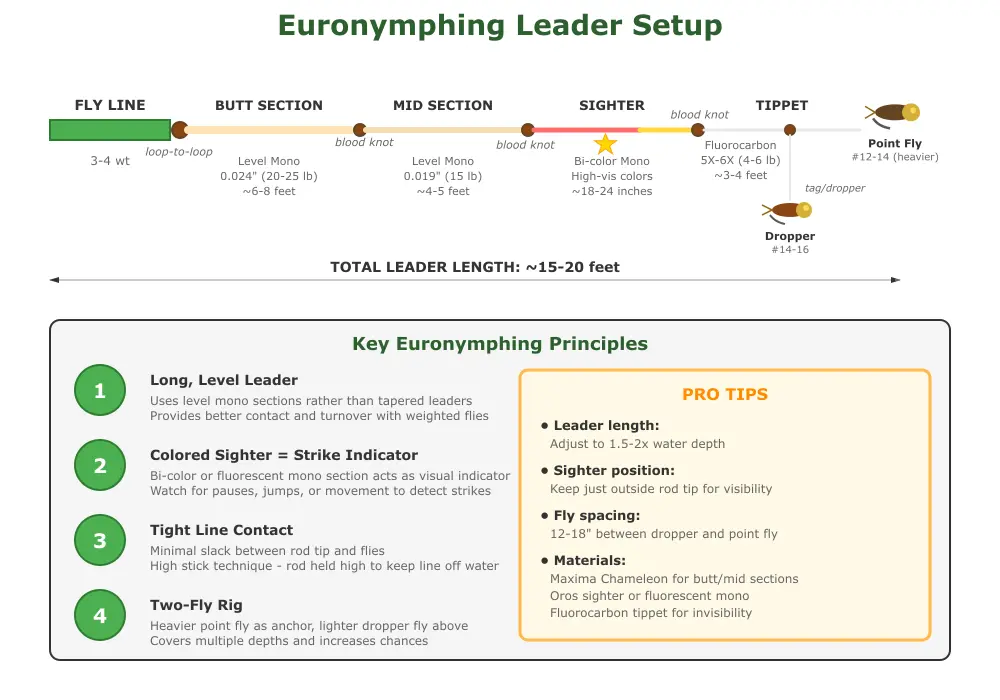Euro Nymping: What's a sighter and How do I build one?

Sighters for Euronymphing
A sighter is a short, high-visibility mono section built into a Euro/mono nymphing leader. It acts as a visual strike detector and a speed reference so you can keep tight contact without using a surface indicator.

General details about sighters
- Function: Detects strikes (pauses, kicks, lifts), shows drift speed/angle, and helps confirm bottom contact.
- Typical length: 18–24 in (45–60 cm) for trout; 30–40 in (75–100 cm) for big rivers or low light.
- Diameter:
- Trout: 0.18–0.23 mm (4–6 lb) bi-color mono.
- Big rivers / heavy flies (e.g., huchen-style rigs): 0.28–0.33 mm for durability and to resist twisting.
- Colors: Bi- or tri-color segments (e.g., pink/green, orange/chartreuse/white). Alternating colors improve visibility across light backgrounds.
- Placement: Between mid-section and tippet (details below).
When and why to nymph using a sighter
| Situation | Why a sighter helps | Notes |
|---|---|---|
| Clear water, subtle takes | Shows micro-pauses you won’t feel | Use slim beads and a fine, stiffer sighter |
| Mixed glare / variable light | Color change stays visible when one color vanishes | Alternate pink/green or orange/white |
| Long leaders / mono rigs | Visualizes drift speed and lane | Keep sighter mostly off the water |
| Winter & cold flows | Fish nip softly; contact matters | Slightly longer sighter aids posture |
| Learning Euro timing | Teaches proper leading angle | Watch for smooth downstream-and-in track |
How to fish the sighter (and avoid sag)
- Keep it aloft: Hold the sighter just above the surface or only the bottom color kissing the film.
- Correct angle: Track at ~10–30° downriver from the rod tip; if it bows or droops, you’re too light or leading too far.
- Contact test: You should see tiny rhythmic “ticks” or a steady, in-lane glide. No movement = slack.
- Weight to the lane: If the sighter sags, increase bead size or lengthen point tippet by 10–20 cm to reach bottom faster.
- Micro-lifts & drops: Lift 5–10 cm to skip a rock, then re-drop to re-engage; the sighter should smoothly follow—no swings.
- Wind control: Shorten the exposed sighter and lower the rod a touch; step closer rather than casting farther.
Quick fixes for sag
- Go heavier bead (e.g., 3.0 → 3.5 → 4.0 mm).
- Shorten the distance rod-tip → sighter.
- Remove unnecessary line from the guides.
- Switch to a stiffer/ thicker sighter (0.23–0.28 mm) in wind.
Where the sighter fits (leader position)
Standard Euro / Mono-Rig layout

Sighters for Euronymphing
Big-river (e.g., huchen) tweak: Use a slightly thicker sighter (0.28–0.33 mm) and 0X–1X to point for abrasion control.
Build options (what to use)
| Option | What it is | Pros | Cons | Typical specs |
|---|---|---|---|---|
| Pre-made bi/tri-color | Factory indicator mono (Cortland/SA/Troutline, etc.) | Easiest, consistent colors | Fixed color order | 18–24" of 0.20–0.25 mm |
| Single-color bright mono | Amnesia/Neon mono section | Cheap, widely available | Less contrast in changing light | 18–24" of ~20 lb |
| DIY multi-color | Splice 2–3 colors with blood knots | Best contrast; customizable | Requires knotting | 3× 6–12" sections, total 18–24" |
DIY multi-color sighter (step-by-step)
- Materials
- 2–3 spools bright mono (pink, chartreuse, white/orange; ~20 lb for stiffness).
- Tippet rings (2–3 mm), UV glue (optional), nippers.
- Cut sections
- 6–12" (15–30 cm) per color; total 18–24".
- Join sections
- Blood knots (5–7 wraps each side). Trim tags short; add a tiny UV touch if desired.
- Install in leader
- Blood-knot the completed sighter between mid-section and a tippet ring.
- Attach working tippet to the ring; build your tag/point from there.
Where the sighter fits (table view)
| Component order (butt → flies) | Notes |
|---|---|
| Fly line / mono mainline → Butt → Mid → SIGHTER → Tippet ring → Working tippet (to tag knot) → Tag + Point | Keep the sighter close enough to the rod tip to see it clearly; avoid having it lie on the water unless you’re intentionally “greasing” it for distance. |
Final tips
- Treat the sighter as a measuring instrument—not a bobber. If it isn’t telling you speed and tension, retune weight/angle.
- Change weight first, then leaders/length, then color.
- Pre-build three sighters (bright day, glare day, snow/foam) and swap with a simple blood knot or ring.
The World's Most Complete Fishing Resource
We're building the ultimate fishing encyclopedia—created by anglers, for anglers. Our articles are created by real experienced fishermen, sometimes using AI-powered research. This helps us try to cover every species, technique, and fishing spot imaginable. While we strive for accuracy, fishing conditions and regulations can change, and some details may become outdated or contain unintentional inaccuracies. AI can sometimes make mistakes with specific details like local access points, parking areas, species distributions, or record sizes.
Spot something off? Whether it's an incorrect boat ramp location, wrong species information, outdated regulations, or any other error, please use the "Help Us Improve This Page" section below. Your local knowledge makes this resource better for every angler.
Explore Related Topics
Discover more articles to deepen your knowledge
Curating articles for you...
Create your own Research Page using AI
Try our AI assistant for free—sign up to access this powerful feature